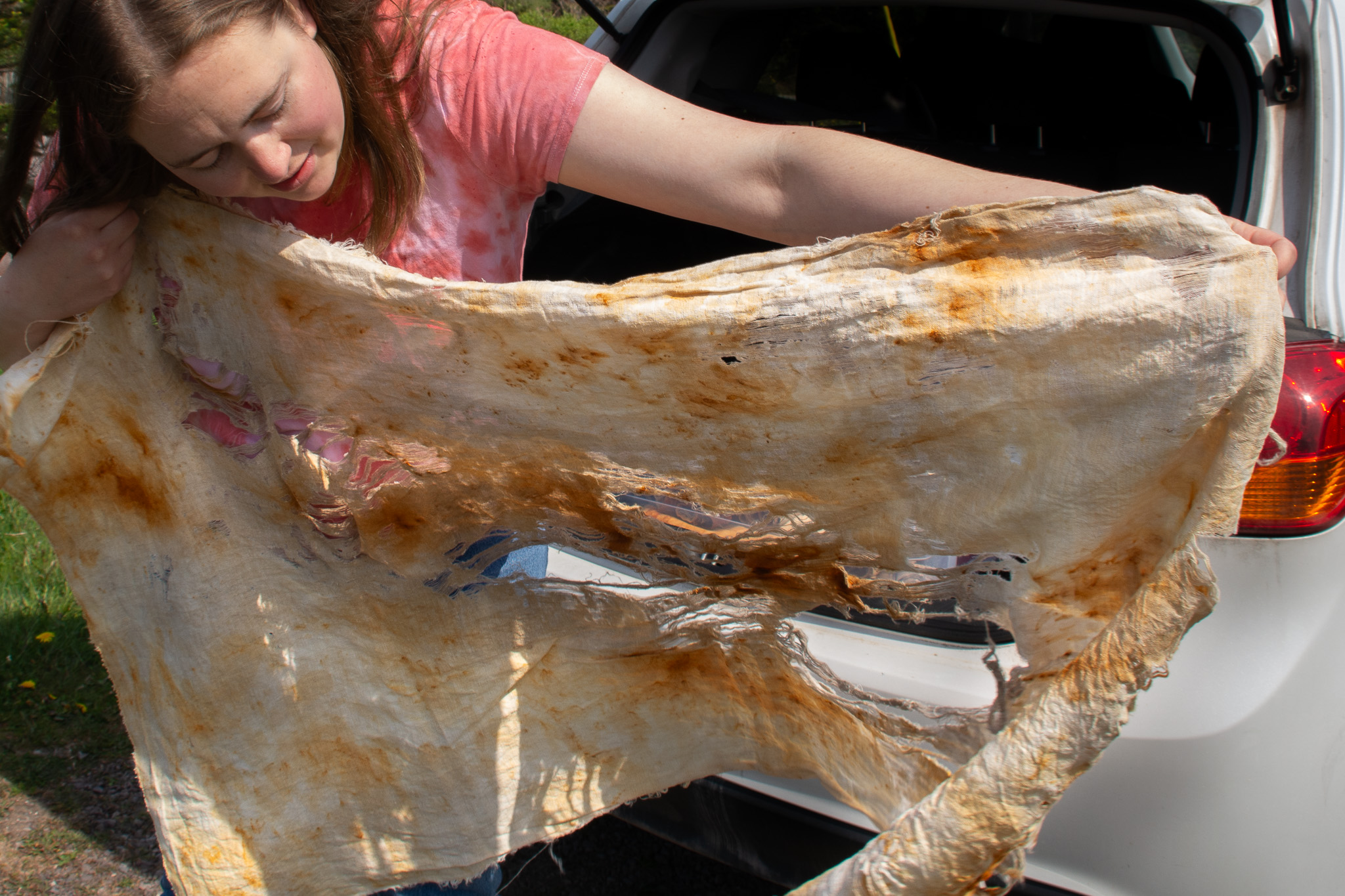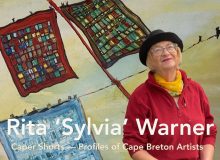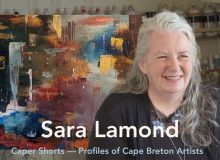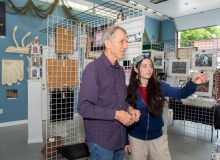Josephine Clarke
Whatever direction her craft and art have taken her, it is always informed by textile
You might say that Josephine Clarke’s textile career has taken a couple of sharp turns and is now way off the beaten path. “In high school I sewed all the time,” she said, “I made all my own clothes.” Then in university she was working with cutting age technology and fabrics culminating in a precision made archery jacket with pockets cut with a laser.
But after graduating she traveled across the country (she’s from BC) to an artisan incubator in Cape Breton, pivoting to dyes she made herself and working with natural fabrics. Today, though, she is using post-industrial junk she finds and combining it with anything that coexisted with said junk. And textiles, of course. “Textile informs everything I do,” she says.
She showed us a tapestry made by strapping a large cloth over an old car engine for five months so the rust could make its imprint. Then she dyed it with dyes made from foraged plants and hardened it. It was like a ghostly mandela and brought to mind the Shroud of Turin.
In her studio there were textile sculpture experiments like a large stiffened cloth folded into undulations and repurposed scrap wood wall hangings accented with ferns, pine cones and fabric suggesting mushroom shapes. She held her hands together forming a circle to show us the size of two gigantic industrial bolts that she scavenged that are the inspiration for her next rust project.
Another sculpture in her studio was made from two old hay cutting bars standing upright with alder branches woven through the parts, all found together on the same site. Josephine says things that are found together are bound together. She thinks of them as a singularity. “These man-made activities happen in the land and I’m just finding what people left behind. And they’re already attracted to each other,” she said. They’re not the same thing but they’ are expressing the same thing. “What I do with them is deliberate but minimal.”
The location itself is also an important element. “The space where I forage, the space where I salvage gives inspiration to the piece — I can’t create unless I know about the space.”
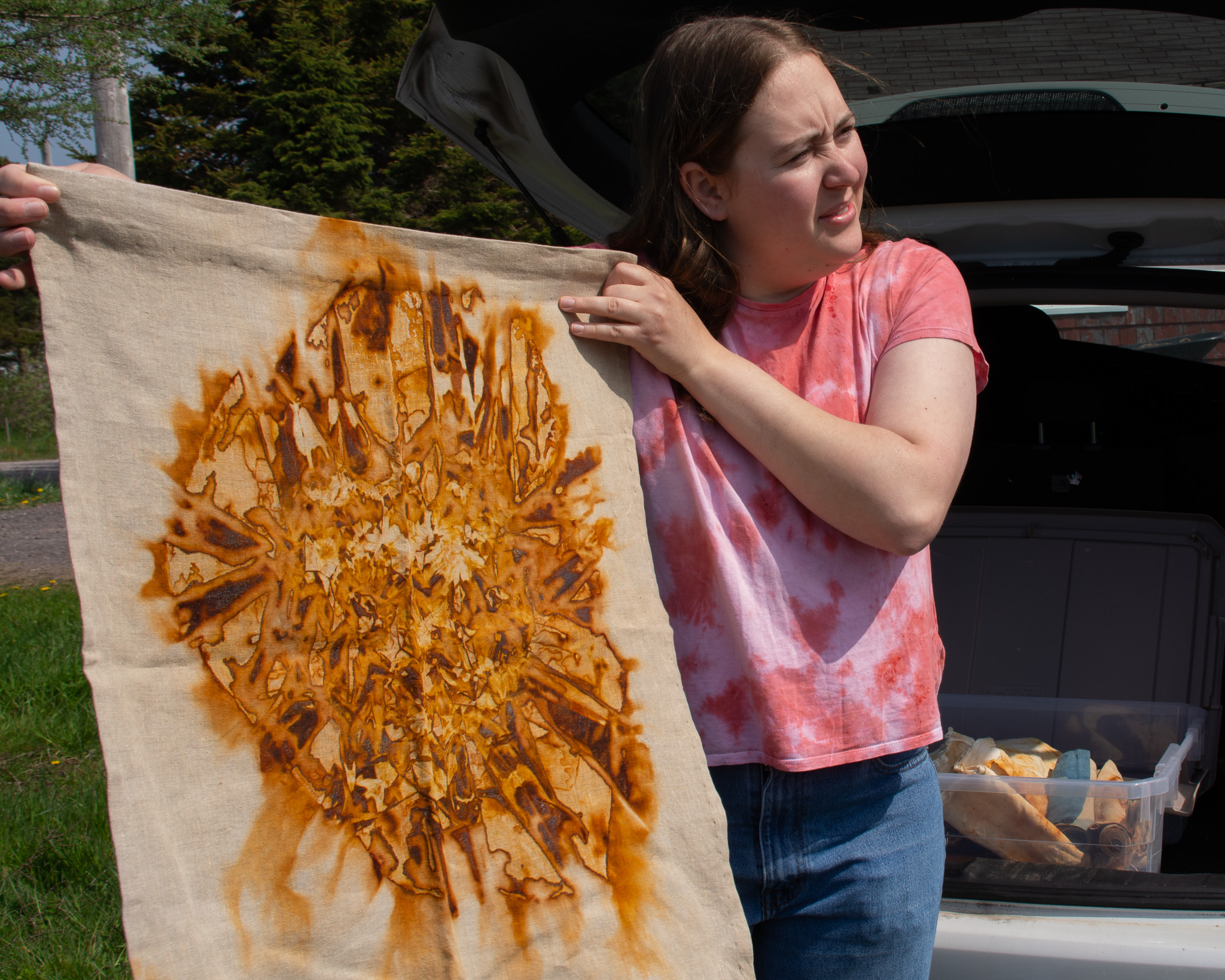
It’s all connected
Sewing, sculpting, plants and junk, Josephine sees them as all connected. She has a relationship with them. At first foraging was about knowing and understanding local plants, but it also brought a dawning awareness of how much junk is out there on the land — in the fields and forests and on the shores and the banks.
It was impossible to ignore it so in 2020 “I started working with junk.” She admits to liking “dead machines” and expressing themes of decay, dissipation and transformation, all revealed by the detritus of civilization. ”You’ll find old junk overgrown by roots. And it makes sculptures on its own and I noticed the way it makes patterns, finds ways to communicate. I find both beauty and sadness in that — the land has a way of taking back and taking over.”
A layer of activism
But junk is not inert. It oozes, decomposes, breaks down, and often damages the environment in the process. This desecration by junk can add another layer of artistic expression that looks like activism. For example, Josephine forages near Auld’s Cove, close to a picnic spot where she discovered that old railway spikes from railway maintenance “that probably still have creosote on them, have been ripped up and discarded into the water.” It makes her mad. “I have an attitude. I have a fuck-you attitude. I go and pick all these railway spikes and say, ‘Fuck you for putting these here. I’m going to show people you’re putting these here.’”
She believes that people have become desensitized to environmental degradation. “I think the indifference is what I explore. The indifference is what is strange to me. I don’t know how to get past that. That’s the thing that weighs the heaviest on my mind.”
But that indifference can be jolted with something like one of her t-shirts that has a beautiful design on it from being wrapped around a huge discarded and rusty industrial bolt. At the very minimum, it starts a conversation.
Her new studio
For the past few years she’s been working out of the Janvrin Island Community Centre and it’s been a mutually beneficial arrangement, especially during the COVID pandemic; but soon she will have her own studio down the road from the Centre where she lives now. The new space will be a game changer for her. It will look out to the water, rocks and low sandy landforms enveloped by ever-shape-shifting fog that can make you see things that aren’t really there — an evocative and inspirational atmospheric trompe l’oeil.
Time to say goodbye.
As we back out of the driveway, a strange urge overtakes us to gift her a piece of our junk. Other people do all the time, she told us. Ah, but we have the perfect thing — an old metal wheelbarrow wheel thick with flaking rust, thin spokes and a flat unyielding rim that we found in the garbage piles buried in our backyard from the days when people routinely dumped their garbage in their backyards. Know our junk, know our story!
We live in a time when everything needs to be rethought, recycled and renewed and art can express that concretely. “Please,” we’ll say, “do something useful and perhaps beautiful with this backyard dump artifact. Give it new life, surprise us!” Reinventing the wheel, albeit a rusty one, opens the door of vision and possibility.

Her Strange Materials
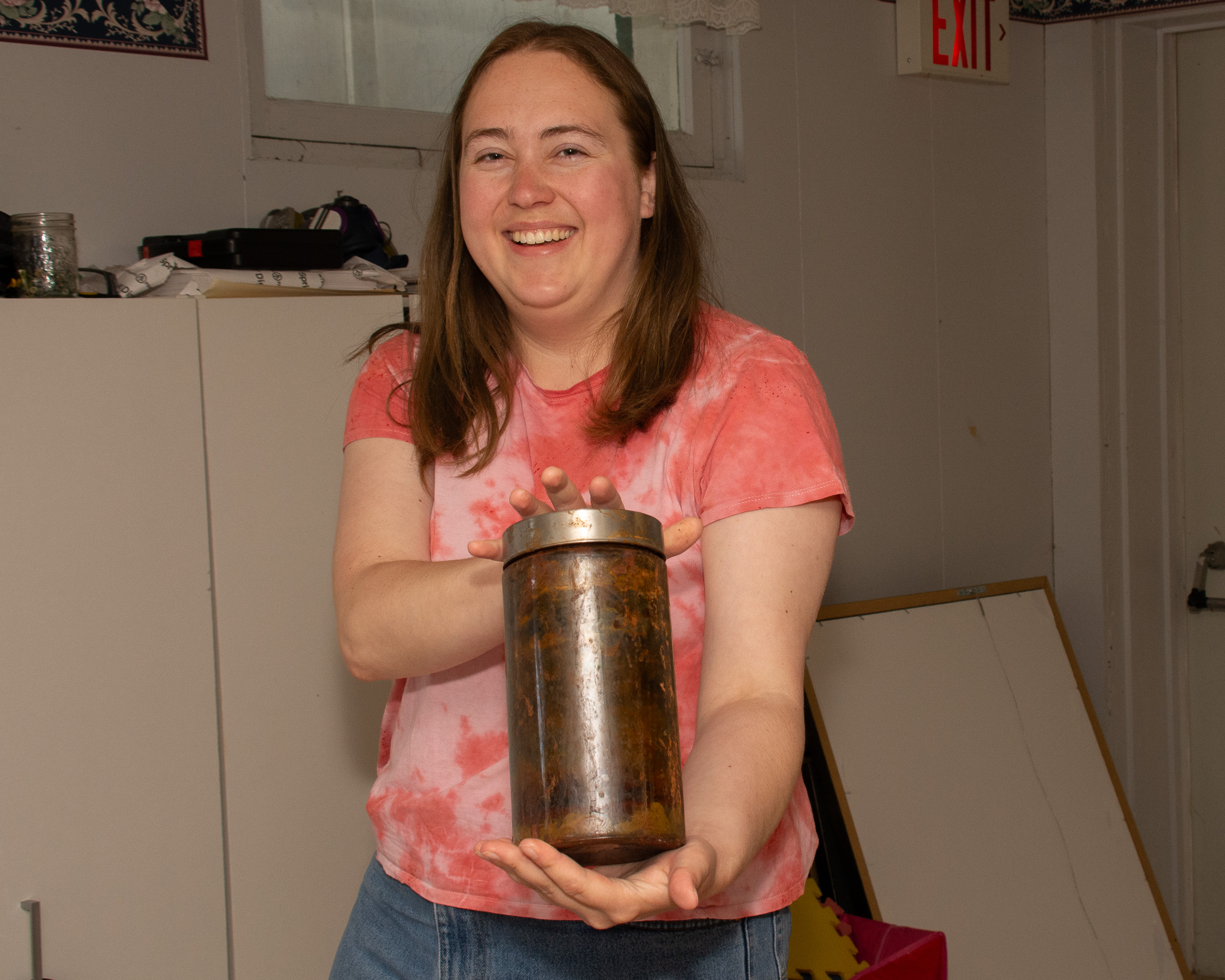
Josephine Clarke has moved through several incarnations from natural dye maker and plant forager to “alchemist” and gatherer of junk.
A kind of hunter-gatherer, but with knowledge of modern chemistry, Josephine Clarke has jars and jars about her studio that need explanation. She looks around for something that might interest us.
Rust
She selects a mad-scientist-looking jar of rust paint liquor which turns out to be an old chain soaking — and rusting — in water and vinegar that you can top off and feed like a sourdough starter. “You can use it like paint,” she says. “I also just pour it into my dye vat to make the colour hold.” In other words, it acts like a fixative, or mordant —as chemists call it — to enhance the dye’s durability.
Also, you can create various colours by combining rust with tannins that occur naturally in some plants. “Rust responds to chemistry,” she explains. “There are clear tannins and brown tannins. Brown tannins will turn black (when combined with rust). Clear tannins will turn purple.” There were many other jars with unidentifiable (to us) things in them, but they might make up an intriguing article of their own.
Foraging
She also forages for plants like lichens, sumac, alder, and fallen birch and goldenrod. Goldenrod is one of her favourite foraged flowers. “It makes a bright yellow color. I can turn it green with iron, too. You can turn it a really earthy green”.
Her garden

We moved outside, down the road where she lives, to see the agricultural aspect of her art — growing her own plants for dyes in her garden at home. She grows plants like Japanese indigo, which she says works with our soil and climate and isn’t invasive like European indigo or woad. She grows calendula, marigold, madder and safflower.
Safflower is special in that it responds to PH in a very interesting way. Josephine explained, “When you soak it in water you get a yellow dye. That’s not a very good dye. It fades out pretty easily.” A solution is what colourists call turning the colour. “You add an alkaline like washing soda or lye. Do it in increments and keep stirring it, it will turn bright, bright red.”
All of these colorants and dyes are only used with natural fabrics that, at present, Josie purchases. But, she muses, that a logical future direction might involve producing and weaving her own natural fabric like linen, wool or hemp.

About the Artist
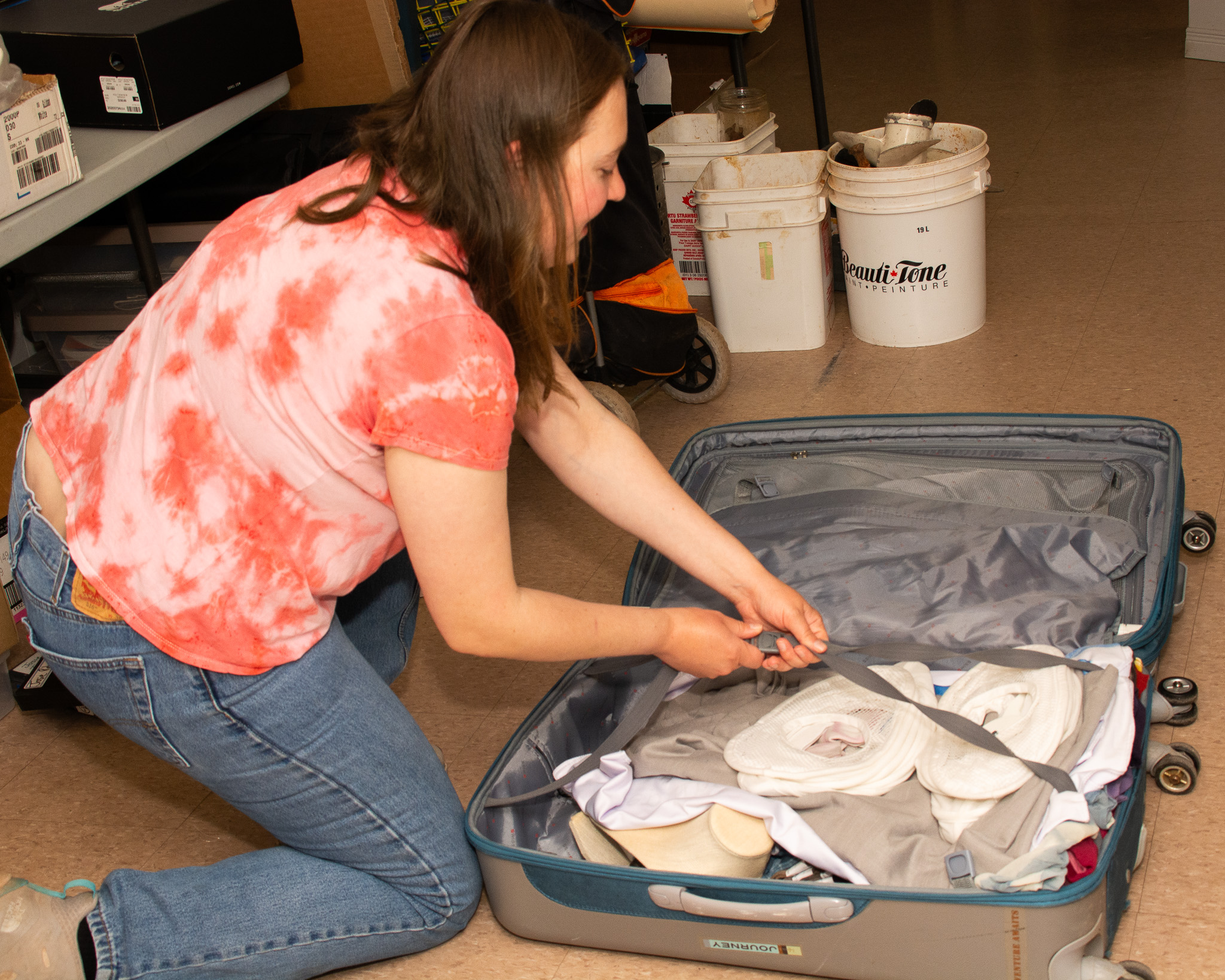
Textile artist Josephine Clarke is originally from the Robson valley in British Columbia and now lives on Janvrin Island in the Isle Madame archipelago off the south end of Cape Breton. In high school she made all her own clothes which led to her pursuing a degree to design and make clothes for a living. She earned her Bachelor of Fashion and Design Technology at Kwantlen Polytechnic University where she was working with all things high tech: machines, software, fabric. However, after graduation she accepted a residency at the Customs House Artisan Incubator in Port Hawkesbury, Cape Breton. There she developed her practice of using natural dyes with natural fibre textiles. You can find her stuff on her site here.
While foraging plants for her dyes she a became a junk enthusiast — sadly, there is no shortage — and began making textile artworks with names like “Nails and Machine Grate”, “Rebar”, “Barrel”, “Stove Remnants” where she’s wrapped fabric around what she calls post industrial junk to see how they interact. The results are both beautiful and slightly unnerving, forcing one to think of all the junk that surrounds us and that we just ignore.
She is an educator with a serious resume and if you want to catch up to her to take in one of her courses, either in person or online, check out her website.
